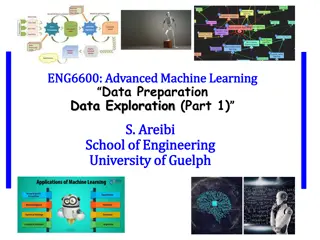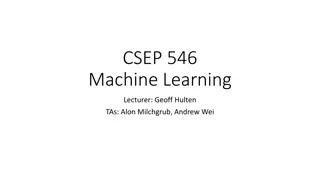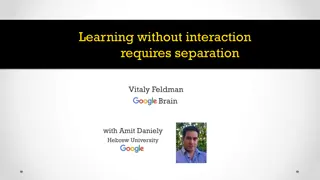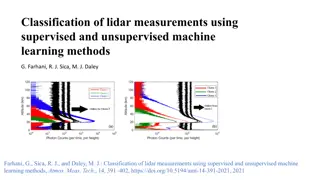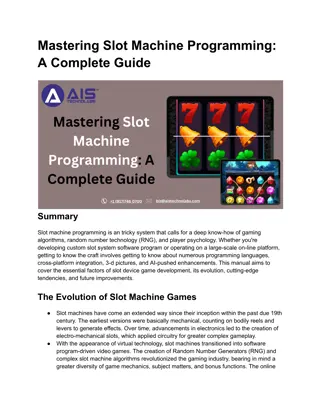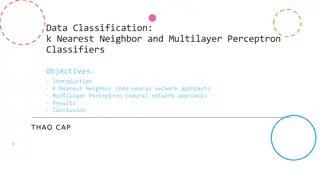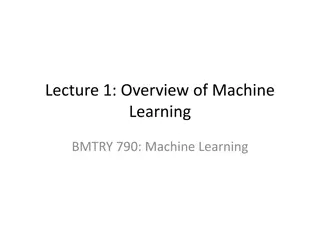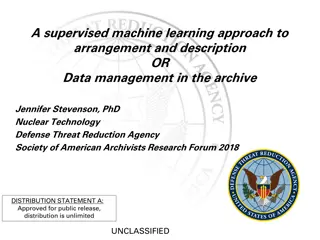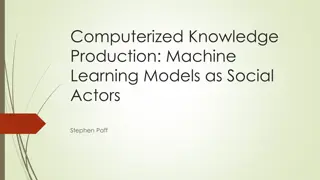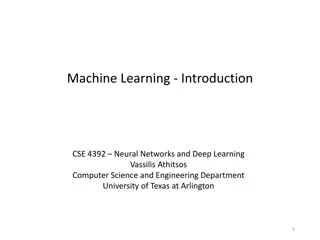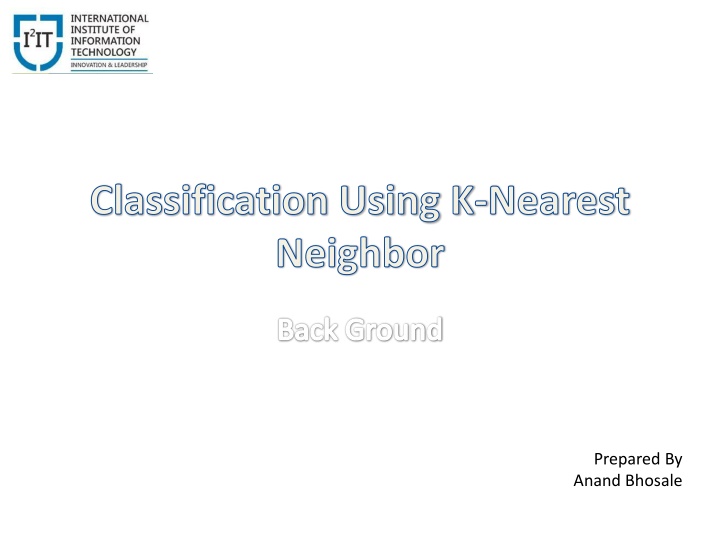
Classification Using K-Nearest Neighbor and Distance Measures
Explore the concepts of classification using K-Nearest Neighbor, distance measures, and properties of distance in supervised and unsupervised learning. Learn about different distance metrics such as Euclidean, Manhattan, Hamming, and Mahalanobis distances, and their applications in measuring similarity between instances. Discover the role of nearest neighbor and exemplars in data analysis, as well as the arithmetic and geometric means in handling data points. Gain insights into measuring distances, including Minkowski and Chebyshev distances, to analyze data effectively.
Download Presentation

Please find below an Image/Link to download the presentation.
The content on the website is provided AS IS for your information and personal use only. It may not be sold, licensed, or shared on other websites without obtaining consent from the author. If you encounter any issues during the download, it is possible that the publisher has removed the file from their server.
You are allowed to download the files provided on this website for personal or commercial use, subject to the condition that they are used lawfully. All files are the property of their respective owners.
The content on the website is provided AS IS for your information and personal use only. It may not be sold, licensed, or shared on other websites without obtaining consent from the author.
E N D
Presentation Transcript
Classification Using K-Nearest Neighbor Back Ground Prepared By Anand Bhosale
Supervised Unsupervised Labeled Data Unlabeled Data X1 X2 X1 X2 Class 10 100 10 100 Square 2 4 2 4 Root
Distances Distance are used to measure similarity There are many ways to measure the distance s between two instances Distance Mahalanobis Distance Euclidean Distance Hamming Distance Minkowski distance
Distances Manhattan Distance |X1-X2| + |Y1-Y2| Euclidean Distance ?1 ?22+ ?1 ?22
Properties of Distance Dist (x,y) >= 0 Dist (x,y) = Dist (y,x) are Symmetric Detours can not Shorten Distance Dist(x,z) <= Dist(x,y) + Dist (y,z) z X y X y z
Distance Hamming Distance
Distances Measure Distance Measure What does it mean Similar"? Minkowski Distance / 1 m N = Norm: = = m ( , ) || || ( ) d x y x y x y m i i 1 i Chebyshew Distance Mahalanobis distance: d(x , y) = |x y|TSxy 1|x y|
Exemplar Arithmetic Mean Geometric Mean Medoid Centroid
Geometric Mean A term between two terms of a geometric sequence is the geometric mean of the two terms. Example: In the geometric sequence 4, 20, 100, ....(with a factor of 5), 20 is the geometric mean of 4 and 100.
Nearest Neighbor Search Given: a set P of n points in Rd Goal: a data structure, which given a query point q, finds the nearest neighborp of q in P p q
K-NN (K-l)-NN: Reduce complexity by having a threshold on the majority. We could restrict the associations through (K-l)-NN.
K-NN (K-l)-NN: Reduce complexity by having a threshold on the majority. We could restrict the associations through (K-l)-NN. K=5
K-NN Select 5 Nearest Neighbors as Value of K=5 by Taking their Euclidean Disances
K-NN Decide if majority of Instances over a given value of K Here, K=5.
Example Points X1 (Acid Durability ) X2(strength) Y=Classification P1 7 7 BAD P2 7 4 BAD P3 3 4 GOOD P4 1 4 GOOD
KNN Example Points X1(Acid Durability) X2(Strength) Y(Classification) P1 7 7 BAD P2 7 4 BAD P3 3 4 GOOD P4 1 4 GOOD P5 3 7 ?
Euclidean Distance From Each Point KNN P1 P2 P3 P4 (7,7) (7,4) (3,4) (1,4) Euclidean Distance of P5(3,7) from Sqrt((7-3) 2 + (7-7)2 ) = 16 = 4 Sqrt((7-3) 2 + (4-7)2 ) = 25 = 5 Sqrt((3-3) 2 + (4- 7)2 ) = 9 = 3 Sqrt((1-3) 2 + (4-7)2 ) = 13 = 3.60
3 Nearest NeighBour P1 P2 P3 P4 (7,7) (7,4) (3,4) (1,4) Euclidean Distance of P5(3,7) from Sqrt((7-3) 2 + (7-7)2 ) = 16 = 4 Sqrt((7-3) 2 + (4-7)2 ) = 25 = 5 Sqrt((3-3) 2 + (4- 7)2 ) = 9 = 3 Sqrt((1-3) 2 + (4-7)2 ) = 13 = 3.60 Class BAD BAD GOOD GOOD
KNN Classification Points X1(Durability) X2(Strength) Y(Classification) P1 7 7 BAD P2 7 4 BAD P3 3 4 GOOD P4 1 4 GOOD P5 3 7 GOOD
References Machine Learning : The Art and Science of Algorithms that Make Sense of Data By Peter Flach A presentation on KNN Algorithm : West Virginia University , Published on May 22, 2015


